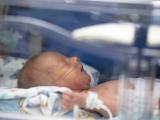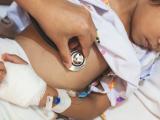Newborns delivered under certain conditions are at very low risk of early-onset sepsis (EOS) and should not need empiric antibiotics, according to the findings of a study published today in Pediatrics.
The study by researchers at Children's Hospital of Philadelphia found that, among 7,549 term and preterm infants evaluated for EOS, which can occur when newborns are exposed to bacteria during the birthing process, there were no cases among those delivered under low-risk delivery characteristics.
Those characteristics, defined in previous studies and confirmed in the findings, include cesarean delivery, absence of labor, no amniotic membrane rupture before delivery, and no concern for infection.
Yet the study also found that 80% of those low-risk newborns did receive antibiotics, and for similar durations as high-risk newborns. The study authors say the findings have important implications for EOS risk assessment and antibiotic management decisions among term and preterm infants.
Determining criteria for low-risk deliveries
The retrospective study, conducted at two Philadelphia birthing hospitals, assessed infants born from 2009 through 2014 who had blood or cerebrospinal fluid culture obtained within 72 hours of birth. The researchers analyzed medical record data for confirmed infections, delivery characteristics, initiation of empiric antibiotics, and duration antibiotics.
The aim was to help determine which delivery characteristics could help clinicians identify which infants, across all gestational ages, are at lowest risk of EOS, and if those characteristics correlate with antibiotic administration and duration. While previous studies have assessed EOS risk among extremely preterm and term infants, few have looked at moderately preterm and late preterm infants, the study authors said.
"Applying low-risk delivery criteria to infants across all gestations may strengthen prediction models in term infants, improve risk categorization among preterm infants, and lead to improved antibiotic utilization in both these populations," they wrote.
Among 53,575 births at the two hospitals over the study period, 7,549 infants (14.1%) had a culture drawn, and 1,121 of those infants had low-risk delivery characteristics. A total of 41 (0.5%) infants had EOS, but none of those infants were from the low-risk delivery group.
Of the 7,508 infants without EOS, 6,713 (89.4%) were started on empiric antibiotics, including 80.4% (901 of 1,121) in the low-risk group and 91% (5,812 of 6,387) in the non-low-risk group. The duration of antibiotics administered to infants born with and without low-risk characteristics was similar (adjusted difference, 0.6 hours; 95% confidence interval [CI], –3.8 to 5.1).
Reducing unnecessary neonatal antibiotics
The study authors say the high prevalence of antibiotic treatment observed in the low-risk infants isn't necessarily surprising, especially in preterm infants, given that EOS can evolve rapidly and be life-threatening. "This is aligned with long-recommended practice, because guidance has historically advocated for the use of antibiotics in all preterm newborns with critical illness," they wrote.
They see the findings as one way to reduce unnecessary neonatal antibiotic use, which can contribute to antibiotic resistance and has been associated with adverse outcomes, disruption of the microbiome, and longer-term morbidities in preterm and term infants.
"In the United States, an estimated 400,000 uninfected term infants receive empirical antibiotics at birth every year, and upwards of 90% of extremely preterm infants receive antibiotics," study author Dustin Flannery, DO, MSCE, an attending neonatologist at Children's Hospital of Philadelphia, said in a press release.
"Our study shows that a well-defined subset of these infants should not need antibiotics, and clinicians can use delivery characteristics as a guide to prevent unnecessary antibiotic use and avoid potential complications of treatment."



















